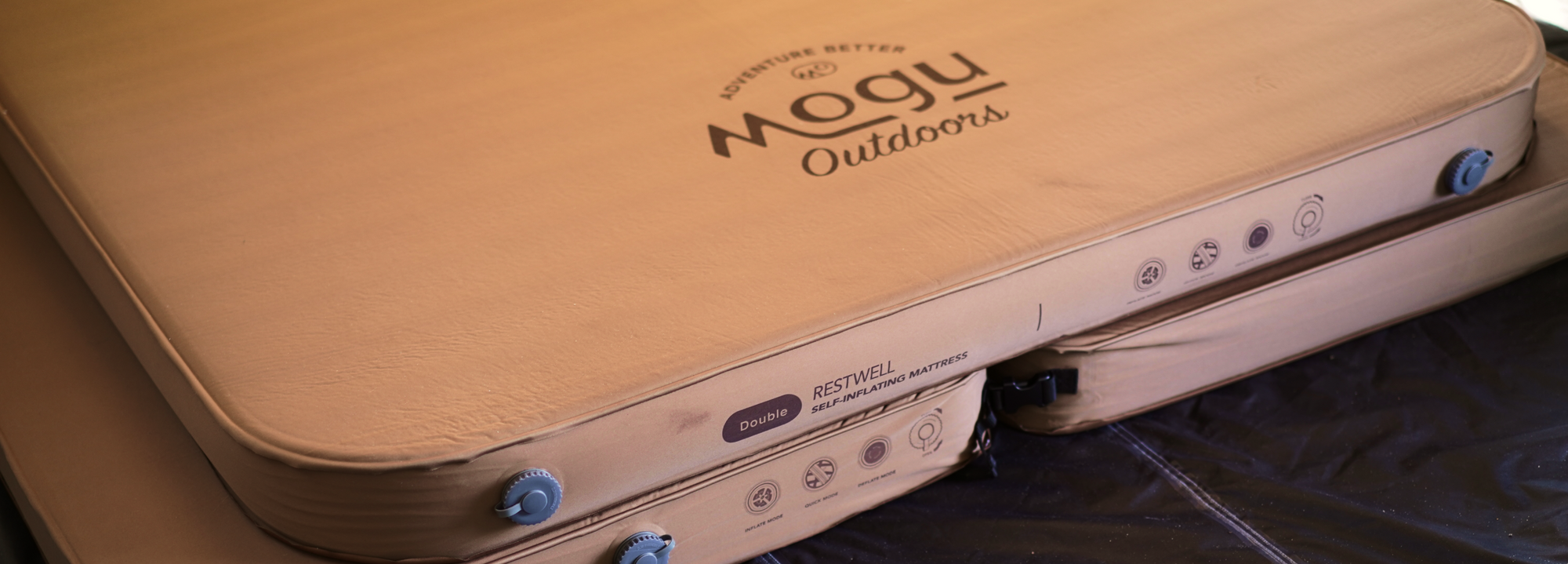You've probably heard the buzz around self-inflating mattresses and how they're quickly becoming the go-to choice for serious campers. But what's all the fuss about?
Let's find out more, with the top 5 questions answered about the self-inflating mattress in our FAQs below.
1. What are Self-Inflating mattresses?
Unlike traditional air mattress or closed cell foam pad, these self-inflating mattresses use perforated foam (crafted from soft polyurethane foam). Special valves are used to control the air when inflating or deflating the mattress. When the valve is in inflate mode, atmospheric pressure pushes air into the foam, causing the small cells within to fill with air and automatically expand the foam. This ensures the pad offers users a comfortable and consistent surface, which is what makes it an excellent sleeping experience.
2. How does Bonded or Non-Bonded affect the mattress?
When shopping for a self-inflating mattress, you might come across some described as "bonded" mattresses. This refers to the top and bottom layers of the mattress (excluding the sidewalls) being adhered to the internal foam. The primary intention behind this is to prevent air circulation between the fabric and foam, ensuring superior insulation from the cold outdoors ground. Additionally, it offers a quieter and more stable experience when you're turning or shifting in your sleep. For example, The Mogu Outdoors Restwell mattresses utilize 30D super stretch fabric and 150D pongee fabric, with TPU lamination to ensure the fabric is airtight. This allows the foam inside to be securely bonded to the fabric.
3. How does the mattress Inflate and Deflate?
Self-inflating sleeping pads come in a variety of brands and models, but their design principles are largely similar. For the Restwell mattress, the general steps are as follows:
-
Natural Inflation: Upon initially opening the valve of the self-inflating camping mattress, the open-cell foam inside will start to intake air. You'll hear the sound of air rushing into the mattress.
-
Adjusting Firmness: Once the foam rebounds to its expected height, you can further inflate more air by breath or using Restwell mattress outer bag to achieve your desired level of firmness.
-
Secure Air Seal: Once the mattress is adjusted to the desired level, make sure the valve is in the inflating mode and then tighten the cap to maintain support and comfort.
-
Deflation: When you prepare to pack up, first have the strap ready nearby. Then, open the valve cap and switch the valve to the "quick deflate" mode. Begin rolling the mattress from the end opposite the valve. After one full roll with the valve set to "quick deflate", change the valve to "deflate" mode and spread out the mattress to roll again. Continue until most of the air has been expelled, tighten the cap, and secure with the strap.
4. Why Isn't My Self-inflating Mattress Fully Inflated on First Use?
The mattress starts inflating when the valve is opened and stops once external atmospheric pressure balances with internal pressure. Based on our testing, sometimes the foam inflates up to a certain level (not yet reaching the desired height) and then stops.
That's because the mattress was vacuum-sealed and rolled up at the factory when it was manufactured, and after a long period of transportation and storage, sometimes foam cells stick together, so the foam is not able to fully expand on first inflation.
But with our Restwell mattresses, this is not a concern. If the foam doesn't expand fully, there's no need to blow into it with your mouth, as that can introduce moisture leading to mould formation inside. Instead, use the outer bag as a pump. This will facilitate quicker inflation and save you the hassle of blowing air into it. After filling, allow a few minutes for the foam to absorb and fully adjust to the air, ensuring all cells are expanded. During this waiting period, it's good time to set up your sleeping bag, pillow, or other camping essentials.
5. What is Insulation and R-Value of the mattress
R Values measure how well something resists heat. For self-inflating camping mattresses, a higher R-Value means it keeps you warmer. To learn more about R Values, you can check the ASTM F3340-22 standard.
In Australia, each state has different climates and temperatures. Take Victoria as an example; spring, summer, and autumn are the best seasons for camping. The weather is just right, and there are more holidays. During these seasons, depending on the temperature, it's suggested to have a mattress with an R Value between 0-5. However, it doesn't mean you can't use a mattress with an R Value higher than 5. Even in warmer summer weather, a higher R Value doesn't mean you'll feel hot. The mattress insulation's job is to block the heat between your body and the ground.
The Mogu Outdoors Restwell self-inflating mattress is 10cm thick with an R Value of 8.9. It's perfect for camping in any season. It's especially good for those who like car camping and want a comfortable sleep. You also can replace the original mattress in your roof top tents or swags if they are not comfortable enough.


